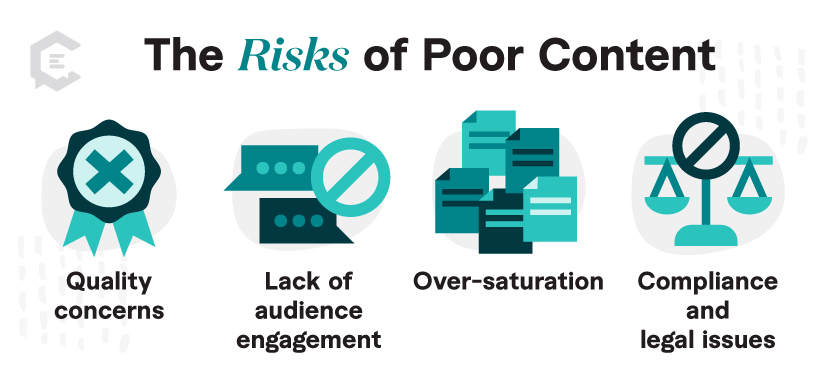The convergence of finance and technology demands effective communication strategies, and that’s where content marketing can play a vital role.
With quality content, fintech companies can educate, engage, and build trust with their audience. Blogs, articles, videos, and infographics can help:
- Explain complicated concepts
- Highlight industry trends
- Share important insights
But with great reward comes risk. Poor-quality content, over-saturated topics, and a weak strategy can lead to limited impact. Learn more about content marketing mistakes in the fintech space and how to avoid them.
The Top Content Marketing Mistakes in FinTech
While content marketing offers many benefits, it also comes with certain risks that organizations need to be aware of.
According to eConsultancy, poor content costs B2B companies $50 billion, resulting in content wastage — when content is produced but goes unused.
The Risks of Poor Content
To help limit content wastage, consider these risks:
- Quality concerns: Poorly written content can harm a company’s reputation and credibility.
- Lack of audience engagement: Failing to understand your audience’s needs and preferences limits your impact.
- Over-saturation: Content that fails to offer a fresh perspective can limit SEO value and fall flat with audiences.
- Compliance and legal issues: Failing to meet regulatory guidelines not only affects your audience, it can put your company in hot water.
Overcoming these content marketing risks can pay off, though. According to Focus Vision, 52 percent of buyers are more inclined to purchase from vendors after reading their content.
Here are some of the most common mistakes and how to avoid them:
1. Neglecting your audience’s needs
Audience is everything in content marketing. This is especially true in the fintech space.
Aligning your fintech content marketing to your audience is crucial. Audience-specific content will be sure to resonate with their specific interests and challenges. The more relevant the content, the more likely is is to capture attention and drive customer engagement.
When content is useful and valuable, it builds trust, credibility, and loyalty among the audience. On the other hand, when content is generic, it can feel unhelpful and even manipulative.
How to avoid it
Knowing your audience is the best way to avoid this content marketing mistake.
Creating personas can help you understand your buyers. Mapping your customer journey can provide an in-depth view of how your potential customers behave before purchasing at every step in the buying process. It also describes how each step leads to the next. So you can ensure your buyer’s journey doesn’t have gaps that cause leads to drop out of your funnel.
To gather information on your audience, you may:
- Track analytics and website behavior
- Poll current users
- Read industry reports
- Track engagement metrics
2 Lacking a well-defined strategy
While it’s true that some content is better than no content, you’ll want to be strategic in the long run. The world of finance and fintech is huge. Marketers may want to look at every money-related topic and write about it.
Content created for the sake of content or to meet some self-imposed publishing schedule isn’t enough. Your content needs to serve your business by supporting your long-term goals.
A successful financial content strategy can help:
- Establish clear goals
- Anchor your content around the audience
- Create consistency
- Demand measurement and accuracy
How to avoid it
The good news is it’s fairly easy to avoid this marketing mistake. Just make sure to sit down and create a content strategy! To create a content strategy:
- Start by defining your goals
- Identify what content types and topics are missing
- Define your audience
- Establish a content creation process
- Create a financial content calendar
- Plan for content distribution
- Track content performance
3. Ineffective use of SEO
Search engine optimization (SEO) is an incredibly powerful tool. While SEO should not be the entirety of your marketing program, it should always be a component.
Aside from generating organic traffic, there are many other reasons why SEO is important.
SEO lets you target intent-driven keywords. This can help you generate high-quality leads simply because your customers use search engines to find solutions to their problems.
Ineffective SEO often uses a ton of resources to yield few results.
How to avoid it
Set yourself up for SEO success at all stages of your content strategy. For example:
- When planning a content calendar, look at search queries.
- Try to have at least one target keyword per content piece.
- Use headings and formatting to make content easy to read.
- Target specific keywords to your audience.
Another way to avoid ineffective SEO is to stay ahead of SEO trends. Search engines like Google continue to tweak their algorithms to better serve users by anticipating intent, language, and preferences. Read industry news and stay up-to-date with changes.
4. Failure to track and analyze results
Tracking content performance in finance can be a challenge. Other marketing tactics — like paid media — have a direct path to measurement. An ad costs $3 per click, ten people clicked, and the company earned $50.
Financial content marketing, however, can feel impossible to measure. Does a blog even generate revenue?
Failing to track and analyze your content marketing causes a number of problems.
For one, you can’t learn from mistakes or build on success. You also can’t show results to management, making it hard to justify the time spent creating content.
How to avoid it
Content marketers can establish key performance indicators (KPIs) to measure the effectiveness of their content marketing strategy. They help track how well the content marketing efforts contribute to the overall business goals.
KPIs could include:
- Revenue
- Leads
- Website traffic
- Conversion rates
- Audience engagement
- Downloads
To track these KPIs, lean on tools like Google Analytics, your CRM, and social media analytics tools.
5. Not using social media
Social media plays a crucial role in fintech content marketing. A strong social media strategy can help marry SEO, audience targeting, and measurement all in one.
Social media platforms have billions of active users. These platforms provide an enormous potential audience for your content. A strong social media strategy can expand your content’s reach even if you have top-notch SEO.
How to avoid it
To use social media more effectively, consider these tactics:
- Engage your social audience with responses and hashtags
- Repurpose and reuse old content to keep social media active and fresh
- Explore niche channels like Facebook groups, Reddit communities, or industry-specific platforms
Solving FinTech Content Marketing Through Outsourcing
Content marketing offers significant benefits for fintech companies.
Successful content helps drive potential customers to your site. Through thought leadership and educational content, you can establish credibility and trust. This leads to enhanced customer loyalty and increased conversions.
Avoiding these mistakes can turn a content marketing program into a cost-effective way to build a business.
If you’re ready to start writing financial content, ClearVoice can help. Discover our vetted and approved financial writers and start creating compelling content that converts.







